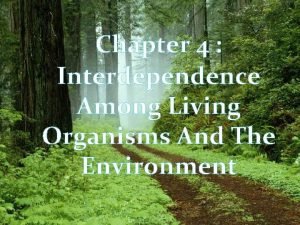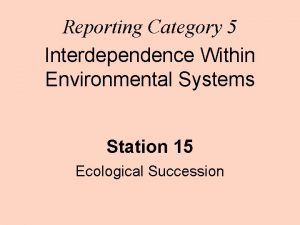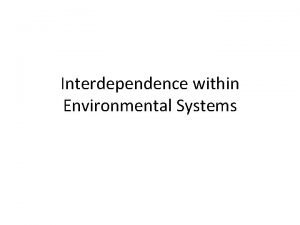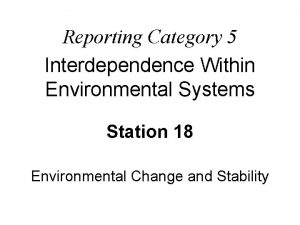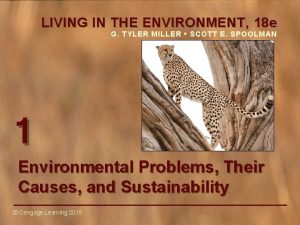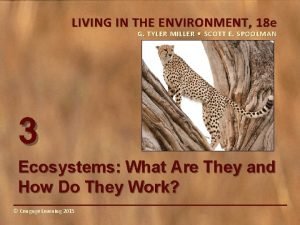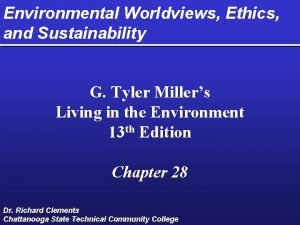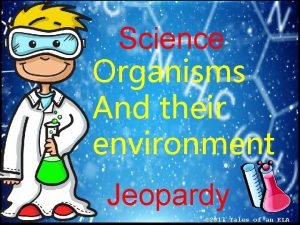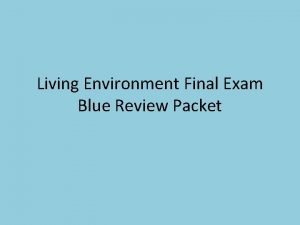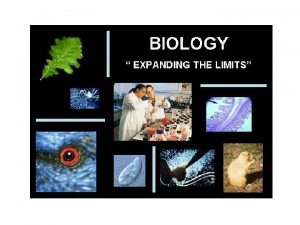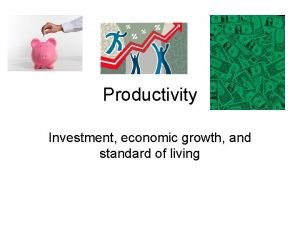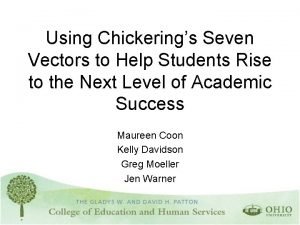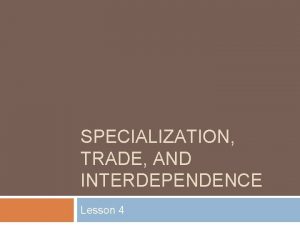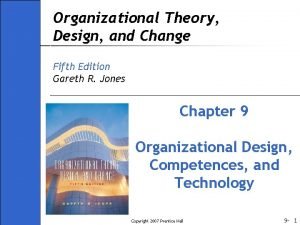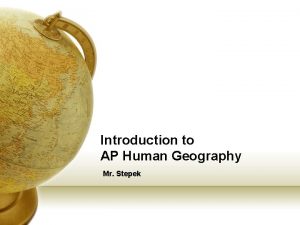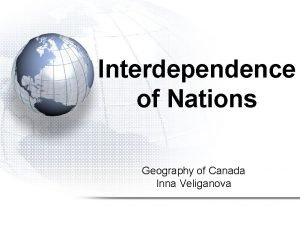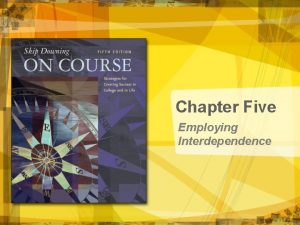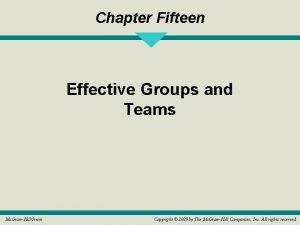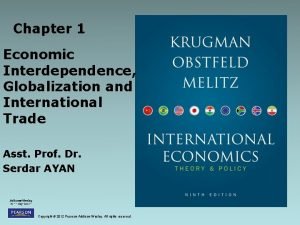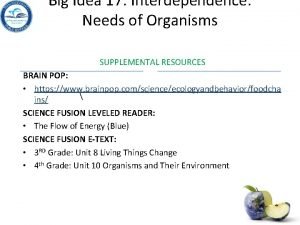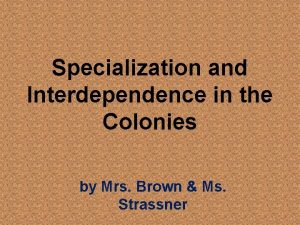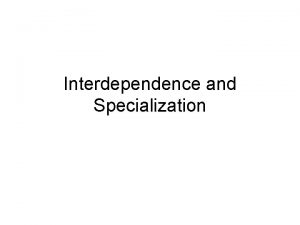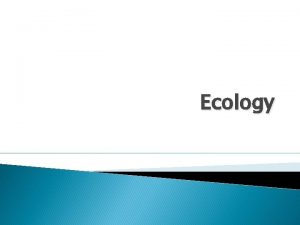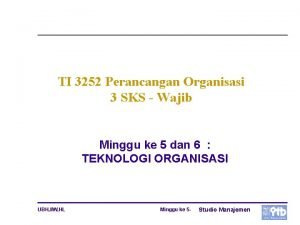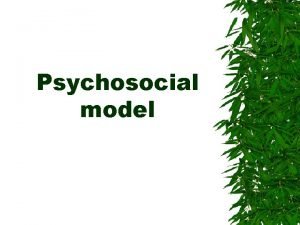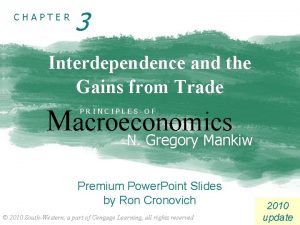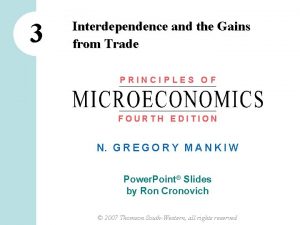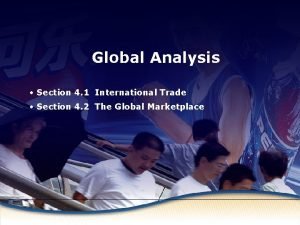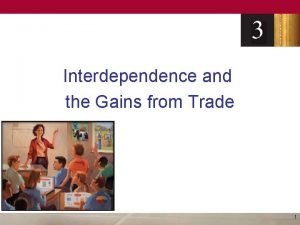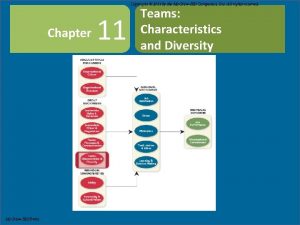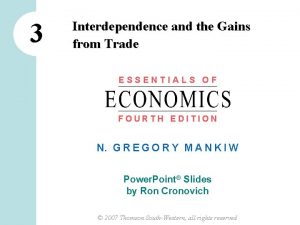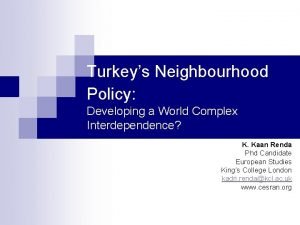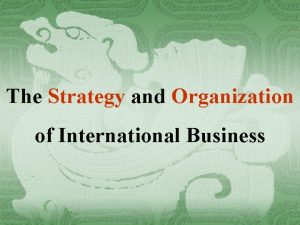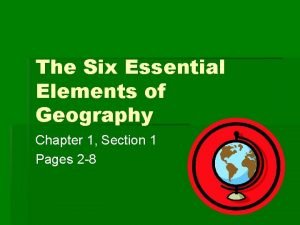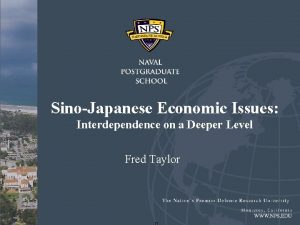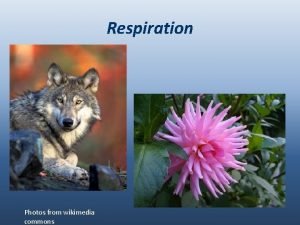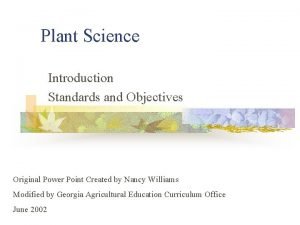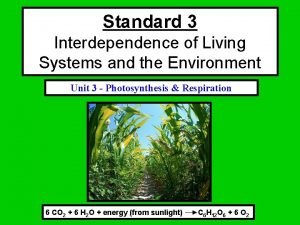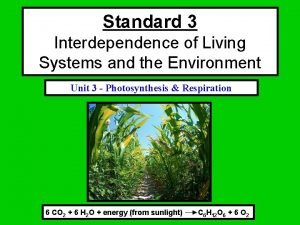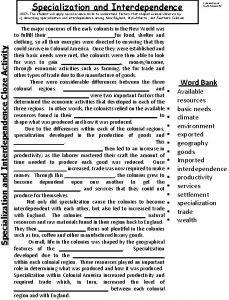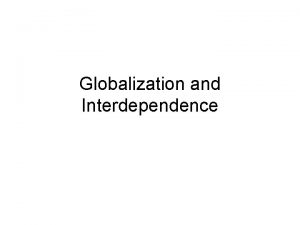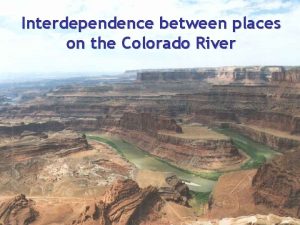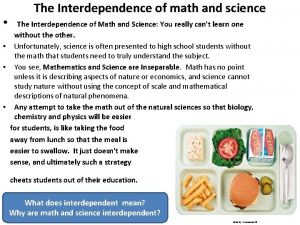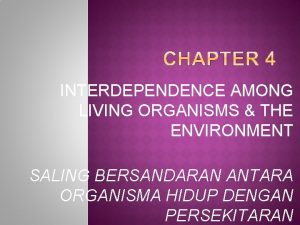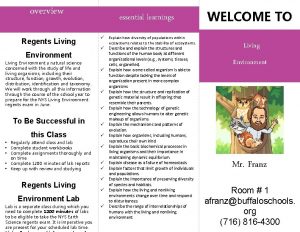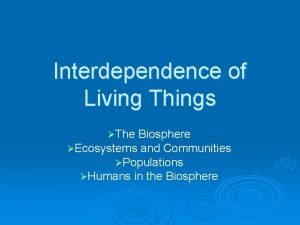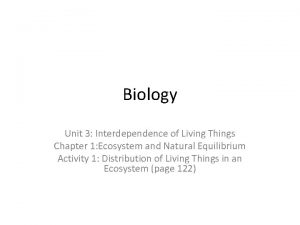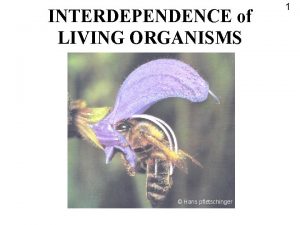Standard 3 Interdependence of Living Systems the Environment














































































- Slides: 78

Standard 3 Interdependence of Living Systems & the Environment Unit 8 – Population Ecology & Human Impacts on Ecosystems

Objectives • B 3. 4 A: Describe ecosystem stability. Understand that if a disaster such as flood or fire occurs, the damaged ecosystem is likely to recover in stages of succession that eventually result in a system similar to the original one. • B 3. 4 C: Examine the negative impact of human activities. • B 3. 5 B: Explain the influences that affect population growth

Questions • How much longer will petroleum resources last? • What effect is the population having on the water system? • What is the effect of recycling paper and aluminum cans?

Human Population Year World Africa Asia Europe Central & Sout h Ame rica Northern Ame rica* Oceania notes 8000 BC 5 000 [5] 1000 BC 50 000 [5] 500 BC 100 000 [5] 1 AD 200, 000 plus [6] 1000 310 000 1750 791 000 106 000 502 000 163 000 16 000 2 000 1800 978 000 107 000 635 000 203 000 24 000 7 000 2 000 1850 1 262 000 111 000 809 000 276 000 38 000 26 000 2 000 1900 1 650 000 133 000 947 000 408 000 74 000 82 000 6 000 1950 2 518 629 221 214 1 398 488 547 403 167 097 171 616 12 812 1955 2 755 823 246 746 1 541 947 575 184 190 797 186 884 14 265 1960 3 021 475 277 398 1 701 336 604 401 218 300 204 152 15 888 1965 3 334 874 313 744 1 899 424 634 026 250 452 219 570 17 657 1970 3 692 492 357 283 2 143 118 655 855 284 856 231 937 19 443 1975 4 068 109 408 160 2 397 512 675 542 321 906 243 425 21 564 1980 4 434 682 469 618 2 632 335 692 431 361 401 256 068 22 828 1985 4 830 979 541 814 2 887 552 706 009 401 469 269 456 24 678 1990 5 263 593 622 443 3 167 807 721 582 441 525 283 549 26 687 1995 5 674 380 707 462 3 430 052 727 405 481 099 299 438 28 924 2000 6 070 581 795 671 3 679 737 727 986 520 229 315 915 31 043 2005 6 453 628 887 964 3 917 508 724 722

In Closed Populations, Growth Rate is Determined by the Difference Between Birth and Death Rates r = birth rate – death rate

Population Growth Reflects the Balance Between Birth and Death Rates For example, Mexico’s population has grown explosively even though its birth rate has declined

Immigration and Emigration Can Strongly Effect Population Dynamics Estimated rates of US population growth with or without immigration.

A Population’s Age Structure Determines Its Potential for Growth Populations with a pyramid-shaped age structure will grow explosively. Populations with a rectangular age structure will grow much slower. Generally, human populations in the developed world are “rectangular” and those of developing nations are “pyramidal. ”

The World’s Human Population Has Grown Explosively in the Past 200 Years Continued rapid human population growth is one of the greatest strains on the health of ecosystems and humanity.

Human Population Growth Is Unevenly Distributed The recent increase in human population in the developing world is due primarily to decreased death rate, not increased birth rate.

Human Population Density Varies Widely

The Carrying Capacity for Human Populations Is Unknown Although a precise figure isn’t known, it’s clear that carrying capacity is influenced by technology.

World Population Growth is Slowing The major factor is declining fertility rates.

World Population Growth is Slowing Population structure of Kenya in 2000 and projections for 2050.


BIOMAGNIFICATION • Biomagnification = a substance gets more concentrated as it passes through the food chain. Example – DDT • The concentration effect occurs because DDT is metabolized and excreted much more slowly than the nutrients that are passed from one trophic level to the next. So DDT accumulates in the bodies (especially in fat). Thus most of the DDT ingested as part of gross production is still present in the net production that remains at that trophic level.

Biomagnification is the bioaccumulation of a substance up the food chain by transfer of residues of the substance in smaller organisms that are food for larger organisms in the chain. It generally refers to the sequence of processes that results in higher concentrations in organisms at higher levels in the food chain (at higher trophic levels). These processes result in an organism having higher concentrations of a substance than is present in the organism’s food. Biomagnification (00: 59)

Succession • Succession = gradual change of a site into a different ecosystem • Pond → Swamp → Meadow → Forest Stages of Succession (01: 14)

Primary Succession at Glacier Bay, Alaska Factors That Influence Succession (05: 46) A climax community is the stable community at the final stage of succession.

Sand Dune Succession • Where a series of dunes has formed at the back of a beach, the youngest dunes will be closest to the shore and the oldest furthest away. • This is one of the few examples where all the stages of a succession can often be clearly seen in one place. Dune Building Pioneer Stage – Foredunes Yellow (White) Dune Stage Conifer Plantations

Model of Dry Dune Succession Dunes' stages can be connected, but they don't have to be. A single dune can go through all the stages without having another dune next to it. However, most of the dunes are connected to other dunes often in other stages of Succession. New dunes are constantly being formed near the beach, as seen above, a dune has just started Succession, although it has been growing for many years.

Nature’s Complexity • Hierarchical Organization LESS understanding MORE understanding • • • Landscapes Ecosystems Communities Species Populations Individuals Organ systems Organ tissues Cell organelles Molecules = Ecologist’s realm

Population Ecology • Scientific study of individual populations and their interaction with, or response to, the environment. • Population = all the individuals within a species • Carrying Capacity = the population or # of individuals an ecosystem can hold/sustain • Sustainability = the ability of an ecosystem to support a population indefinitely Population size Time Learning Ecological Terms (07: 23)

Populations – Communities - Ecosystems • Organisms of one species form a population. • Populations of different organisms interact to form communities. • Living communities and the nonliving factors that interact with them form ecosystems. – List all components (biotic & abiotic) in a pond ecosystem Population and Community (02: 19)

Levels of Ecological Investigation

Population Ecology A population is a group of individuals of the same species that occupy a specified region at a specified time. Key questions of population ecology include: What is the size of a population? What is the potential for growth in the population? What form will growth take?

Community Ecology Community ecology examines the question of how populations interact. Questions include: What are the types of species and their numbers within a community (i. e. community structure)? Are there especially critical species for maintenance of the community? What is the relationship (predator, prey, parasite) between species within the community?

Community Ecology • The study of groups of species that live together in a particular area or habitat. • Habitat = place where a species lives (human habitat Habitats (00: 38) = house) Interspecific Interactions Populations, Habitats, and Niches (03: 30) +/o Commensalism +/+ Mutualism +/- Parasitism Parasitoidism Herbivory + / - - Predation -/- Competition Types of Interactions Within Ecosystems (04: 35)

Interdependency • Two organisms can be mutually beneficial and that can lead to interdependency. • Interdependency = mutuality: a reciprocal relation between interdependent entities (objects or individuals or groups). – Apples & Honey Bees

Mutualism occurs when species interact in a mutually beneficial manner. The oxpecker gets food (ticks and insects disturbed in the grass) and a safe haven from the rhinoceros, and the rhinoceros has parasites (ticks) removed. Relationships Between Populations: Symbiotic (02: 30)

Mutualism Mycorrhizal fungi (threads) covering aspen roots: fungi aid in water and nutrient absorption by the aspen and the aspen provides sugars and other food molecules to the fungi.

Parasites • A parasite is an organism that lives in or on the living tissue of a host organism at the expense of that host. The biological interaction between the host and the parasite is called parasitism. • A parasite is an animal or plant that lives in or on a host (another animal or plant); it obtains nourishment from the host without benefiting or killing the host Tapeworm Whipworm

Parasites • Almost everyone has parasites. It’s simply a fact of life. Even Dr. Oz, the now famous Oprah Winfrey guest says. . . "ninety percent of humans will have a problem with parasites in their lifetime. " Parasites are not just something that other people get – a malady reserved for citizens of developing countries. Everywhere we go, during just about everything we do, North Americans are vulnerable to parasitic infestation. • The World Health Organization (WHO) classifies parasites as among the six most dangerous diseases that infect humans. Parasites outrank cancer as the number one global killer, and account for many of the digestive woes from which people suffer. Hookworm Roundworm Parasitic Worms of the Animal Kingdom (05: 06) Mosquito

Parasites • Homework - Diagram the stages of the life cycle for a human disease-causing organism.

Biodiversity There are many measures of biodiversity. Considering species diversity, more diverse communities tend to be more productive. The role of diversity in community stability is less clear.

Biodiversity Remember, however, that this is one set of communities.

Why Worry About the Relationship Between Biodiversity and Community Stability? Because this understanding is essential for knowing how many species and of what types can be lost before a community collapses. Connected Systems: Biodiversity, Ecosystems, and Ecology

Biodiversity Varies Naturally There is a trend towards more species in warmer, wetter areas and fewer in colder and drier areas. Why Should We Care? (04: 22) Numbers of bird species occupying areas of North America.

Science (2005) 309: 90 We really don’t have a satisfying answer to this fundamental question.

There are Biodiversity “Hotspots” Biodiversity hotspots for tropical rain forest and chaparral ecosystems. Less than 1% of Earth’s surface supports 20% of known plant species and probably a greater portion of animal species. Biodiversity hotspots are significant for conservation plans.

Biodiversity is Being Lost Rapidly Through Extinction How rapid is the current rate of extinction? The number’s hard to pin down, but generally accepted estimates put it at 10 -100 times the rate before extensive human–induced environmental modifications. For example, in the U. S. ~ 225 vascular plant species have become extinct in the past 50 years and about 650 of the remaining 20, 000 species are threatened.

Community Ecology • Predator-Prey Relationship = 2 species have a relationship where the population of one affects the population of the other one • The predators -- eat the other -- the prey • Such pairs exist throughout nature: Predator-Prey Relationships: The – lions and gazelles, Example of the Bobcat and Rabbit (01: 44) – birds and insects, – pandas and bamboo, – Venus fly traps and flies – http: //www. accessexcellence. org/AE/AEPC/WWC/1991/predator. html

Predator-Prey

Equilibrium • As the number of carnivores in a community increases, they eat more and more of the herbivores, decreasing the herbivore population. It then becomes harder and harder for the carnivores to find herbivores to eat, and the population of carnivores decreases. In this way, the carnivores and herbivores stay in a relatively stable equilibrium, each limiting the other's population. A similar equilibrium exists between plants and plant-eaters.

Predation, Parasitism and Coevolution Predation (consuming another organism) and parasitism (feeding upon a host organism without causing its immediate death) drive an evolutionary arms race. Predator and prey, host and parasite are locked in a duel to outwit their opponent through adaptations. Predator and prey interactions drive coevolution – coupled adaptive changes in interacting species.

Reproductive Strategies • Describe different reproductive strategies employed by various organisms and explain their advantages and disadvantages. • Although every organism struggles to survive, individual survival is not enough to ensure continuation of the species. Individuals must reproduce. • Scientists have identified two strategies for leaving living descendants. These strategies are called the r-strategy and the k-strategy. Some organisms, animals and plants, use one strategy or the other: some seem to tend towards one but are closer to a sort of mid-point. Let's compare these strategies. • Hint - Remember that R stands for Rapid so that you will remember which strategy is which. R-Selected parents rapidly produce many descendents, but do not provide care for them.

Reproductive Strategies r-selected K-selected mature rapidly mature slowly short-lived: most die before they reproduce tend to live long lives: low juvenile mortality rate compete well for resources have many offspring - tend to overproduce have few offspring at a time invest little in individual youngsters care for their young most pest species are r-selected most endangered species are Kselected population not regulated by density: boom and bust population figures population stabilizes near carrying capacity opportunistic -- invade new areas maintain numbers in stable ecosystems

Reproductive Strategies • We see that r-selected organisms have many babies, but most of these youngsters never become adults. Frogs are a good example of r-selected organisms. Frogs lay many eggs and leave them in the water to hatch into tadpoles. Some of the eggs get eaten, and many of the little tadpoles are eaten, too, by dragon-fly larvae and fishes and fishing birds. When the tadpoles become frogs, many animals are waiting on shore to eat them: raccoons, foxes, snakes, cats, and many other small predators. If one frog from a hundred eggs lives to be a parent, his/her survival is really outstanding. But frogs go on because they lay so many eggs.

Reproductive Strategies • Elephants are examples of Kselected animals. Female elephants have babies about three years apart, and they have only one each time. The whole group looks after the youngsters, and protects them through childhood and adolescence. By reproducing at a rate that holds their numbers close to constant, elephants are able to survive in stable ecosystems. Because they ensure the survival of a good percentage of their young, elephants do not need to produce many elephant babies

Reproductive Strategies - Farm • Cattle - Heifers become sexually mature cows at between 15 and 27 months; bulls are mature at 1 year. Gestation is about 9 months. Cows can't be milked unless they have given birth, so each female is expected to produce at least 1 living calf every year. In the U. S. beef cattle calves are usually born in the spring; they stay with their mothers until weaned and are sold off in the fall. Cows have a calf in the spring and are breed again in early summer when the calf is only about 3 -4 months old. • Swine - Sexual maturity of a gilt can be reached between 8 and 10 months of age. Sows usually have litters of from 1 to 15 young, generally 8 being average. Females are extremely protective of their young. Gestation is 3 months, 3 weeks, 3 days. Piglets are weaned after an average of 4 -5 weeks. The sows will recondition and get rebreed to have their second litter for the year. • Mouse - Sexually mature at 4 -7 weeks (both males and females) with a life expectancy of 1 -3 years. Cycle of heats every 4 -5 days, continuing all year round with a gestation period of 19 -21 days. Average size of litter is 4 -14 (even more), averaging 12 babies which they nurse for approximately 3 -3. 5 weeks. They are weaned at males 3, 5 weeks, females may be weaned at 4 weeks. They then separate to single sex groups at 3. 5 weeks and are ready to leave for new homes at 1 month of age. Females experience a resting period between matings of at least 2 weeks, preferably over 1 month between weaning of one litter and mating for another.

Invasive Species • Predict the consequences of an invading organism to the survival of other organisms. • The term invasive species refers to a subset of introduce species or non-indigenous species that are rapidly expanding outside of their native range. Invasive species can alter ecological relationships among native species and can affect ecosystem function and human health. A species is regarded as invasive if it: (1) has been introduced by human action to a location where it did not previously occur naturally, (2) becomes capable of establishing a breeding population in the new location without further intervention by humans, and (3) spreads widely throughout the new location. In simple terms, an invader has to (1) arrive, (2) survive, and (3) thrive.

Invasive Species in Michigan • Invasive Species in Michigan: – Crustaceans: Cercopagis pengoi | Rusty Crayfish | Spiny Water Flea Fish: Common Carp | Goby | Ruffe | Sea Lamprey | White Perch Mollusks: Zebra Mussel Plants: Curly-leaf Pondweed | Eurasian Watermilfoil | Flowering Rush | Purple Loosestrife – Insects: Emerald Ash Borer / Japanese Beetle / Asian Longhorn Beetle – Fungus: Soybean Rust

Invasive Species • The emerald ash borer is an Asian beetle that entered the U. S. in the mid-1990 s near Detroit, though it was not officially identified until 2002. It probably arrived in wood packing commonly used to ship all manner of goods. Adult female EABs lay eggs in the crevices of the bark of ash trees. After the eggs hatch, the larvae bore into the tree and eat the cambium layer between the bark and wood. Over time, the galleries created by the borers' feeding activities girdle and eventually kill branches and entire trees. An infested tree typically dies within two to three years. Green ash, white ash, black ash and several horticultural varieties are susceptible to damage by the emerald ash borer.

Invasive Species • Zebra mussels (Dreissena polymorpha) are small, fingernail-sized mussels native to the Caspian Sea region of Asia. They are believed to have been transported to the Great Lakes via ballast water from a transoceanic vessel. The ballast water, taken on in a freshwater European port was subsequently discharged into Lake St. Clair, near Detroit, where the mussel was discovered in 1988. Since that time, they have spread rapidly to all of the Great Lakes and waterways in many states, as well as Ontario and Quebec. Diving ducks and freshwater drum eat zebra mussels, but will not significantly control them. Likely means of spread: Microscopic larvae may be carried in livewells or bilgewater. Adults can attach to boats or boating equipment that is in the water. Zebra Mussels and Other Invasive Species in the Great Lakes Basin (01: 56)

Invasive Species • Purple Loosestrife (Lythrum salicaria) is a wetland plant from Europe and Asia. It was introduced into the east coast of North America in the 1800 s. First spreading along roads, canals and drainage ditches, then later distributed as an ornamental, this exotic plant is in 40 states and all Canadian border provinces. The plant can form dense, impenetrable stands that are unsuitable as cover, food or nesting sites for a wide range of native wetland animals, including ducks, geese, rails, bitterns, muskrats, frogs, toads and turtles. Many rare and endangered wetland plants and animals also are at risk. Likely means of spread: Seeds escape from gardens and nurseries into wetlands, lakes and rivers. Once in aquatic systems, seeds are easily spread by moving water and wetland animals.

Ecosystem Ecology Simple ecosystem model • ECOSYSTEM = The living (biotic) and nonliving (abiotic) organisms which affect the existence of other animals and plants Introduction to Ecosystems and Their Environment (01: 44)

Dynamics Within the Ecosystem • The physical or chemical environment may influence the rate, extent, and nature of population dynamics within ecosystems. • Human welfare ultimately depends in many ways on ecosystem functioning. Most ecosystems on earth are under the influence of physical and chemical stressors, and face a steady change of concentrations and effects of a whole suite of polluting substances.


Ecosystem components • Plants • Decomposers • Animals • Abiotic components: – Water – Atmosphere – Soil minerals


Why should we care about ecosystem ecology? • Ecosystem ecology provides a mechanistic basis for understanding the Earth System • Ecosystems provide goods and services to society • Human activities are changing ecosystems (and therefore the Earth System)


Human Impact • Humans have a tremendous impact on the environment. Sometimes their impact is beneficial, and sometimes it is detrimental. • Greenhouse Effect – – What is the greenhouse effect? The greenhouse effect is a natural warming process of the earth. When the sun's energy reaches the earth some of it is reflected back to space and the rest is absorbed. The absorbed energy warms the earth's surface which then emits heat energy back toward space as longwave radiation. This outgoing longwave radiation is partially trapped by greenhouse gases such as carbon dioxide, methane and water vapour which then radiate the energy in all directions, warming the earth's surface and atmosphere. This is the greenhouse effect. – Increasing the amount of greenhouse gases intensifies the greenhouse effect. Higher concentrations of CO 2 and other greenhouse gases trap more infrared energy in the atmosphere than occurs naturally. The additional heat further warms the atmosphere and Earth’s surface. – Climate models suggest this natural warming is being enhanced by human activities that increase concentrations of greenhouse gases in the atmosphere and greenhouse effect. The increase in atmospheric concentration of greenhouse gases, accentuating the natural greenhouse effect globally, is also called the enhanced greenhouse effect or Global Warming.

We’re in the Driver’s Seat - Human Activities Dominate Many Biogeochemical Cycles


http: //earthguide. ucsd. edu/earthguide/diagrams/greenhouse/

Global Warming • Here's the lowdown on why it's happening, what's causing it, & how it might change the planet. • Is It Happening? • Yes. Earth is already showing many signs of worldwide climate change. • • Average temperatures have climbed 1. 4 degrees Fahrenheit (0. 8 degree Celsius) around the world since 1880, much of this in recent decades, according to NASA's Goddard Institute for Space Studies. • • The rate of warming is increasing. The 20 th century's last two decades were the hottest in 400 years and possibly the warmest for several millennia, according to a number of climate studies. And the United Nations' Intergovernmental Panel on Climate Change (IPCC) reports that 11 of the past 12 years are among the dozen warmest since 1850. • • The Arctic is feeling the effects the most. Average temperatures in Alaska, western Canada, and eastern Russia have risen at twice the global average, according to the multinational Arctic Climate Impact Assessment report compiled between 2000 and 2004.

Global Warming • Is it happening? … • • Arctic ice is rapidly disappearing, and the region may have its first completely ice-free summer by 2040 or earlier. Polar bears and indigenous cultures are already suffering from the sea-ice loss. • • Glaciers and mountain snows are rapidly melting—for example, Montana's Glacier National Park now has only 27 glaciers, versus 150 in 1910. In the Northern Hemisphere, thaws also come a week earlier in spring and freezes begin a week later. • • Coral reefs, which are highly sensitive to small changes in water temperature, suffered the worst bleaching—or die-off in response to stress—ever recorded in 1998, with some areas seeing bleach rates of 70 percent. Experts expect these sorts of events to increase in frequency and intensity in the next 50 years as sea temperatures rise. • • An upsurge in the amount of extreme weather events, such as wildfires, heat waves, and strong tropical storms, is also attributed in part to climate change by some experts.

Global Warming • Are humans causing it? • "Very likely, " the IPCC said in a February 2007 report. • The report, based on the work of some 2, 500 scientists in more than 130 countries, concluded that humans have caused all or most of the current planetary warming. Human-caused global warming is often called anthropogenic climate change. • • Industrialization, deforestation, and pollution have greatly increased atmospheric concentrations of water vapor, carbon dioxide, methane, and nitrous oxide, all greenhouse gases that help trap heat near Earth's surface. • • Humans are pouring carbon dioxide into the atmosphere much faster than plants and oceans can absorb it. • • These gases persist in the atmosphere for years, meaning that even if such emissions were eliminated today, it would not immediately stop global warming. • • Some experts have said that a natural cycle of planetary warming and cooling that alters the amount of sunlight falling on Earth may explain the trend. The planet has indeed experienced such cycles roughly every hundred thousand years, but such changes in the past have manifested themselves over the span of several centuries. Today's changes have taken place over the past hundred years. Other recent research has ruled out variations in solar output as a probable cause.

Global Warming • What's Going to Happen? • A follow-up report by the IPCC released in April 2007 warned that global warming could lead to large-scale food and water shortages and have catastrophic effects on wildlife. • • Sea level could rise between 7 and 23 inches (18 to 59 centimeters) by century's end, the IPCC's February 2007 report projects. Rises of just 4 inches (10 centimeters) could flood many South Seas islands and swamp large parts of Southeast Asia. • • Some hundred million people live within 3 feet (1 meter) of mean sea level, and much of the world's population is concentrated in vulnerable coastal cities. In the U. S. , Louisiana and Florida are especially at risk. • • Glaciers around the world could melt, causing sea levels to rise while creating water shortages in regions dependent on runoff for fresh water. Early light strikes mountains in Montana's Glacier National Park. When the park was created in 1910, it had 150 glaciers. Today, due to melting caused by warming temperatures, there are 30 much smaller glaciers in the park.

Global Warming • What's Going to Happen? • • Strong hurricanes, droughts, heat waves, wildfires, and other natural disasters may become commonplace in many parts of the world. The growth of deserts may also cause food shortages in many places. • • More than a million species face extinction from disappearing habitat, changing ecosystems, and acidifying oceans. • • The ocean's circulation system, known as the ocean conveyor belt, could be permanently altered, causing a mini-ice age in Western Europe and other rapid changes. • • At some point in the future, warming could become uncontrollable by creating a so-called positive feedback effect. Rising temperatures could release additional greenhouse gases by unlocking methane in permafrost and undersea deposits, freeing carbon trapped in sea ice, and causing increased evaporation of water.


Greenhouse Gases and Global Warming

A Warming World

• How are humans part of an ecosystem? • What factors contribute to human population growth? • What are the implications of having a large human population? • How do humans interact with the environment? • How are humans and the environment dependant on each other? • What is sustainable development?

• How are humans part of the biotic community? • What factors limit the biotic life of a community? • What is the biosphere? • What is homeostasis & the impact it has on the environment? • What are some consequences of human alterations to the environment?

What Are the Concerns? Global warming. Loss of biodiversity. Change in species distribution. Collapse of ecosystems. Degradation and collapse of human societies.

An Uncertain Future? Of course … …. but that’s not to say there’s no hope.
 Types of living organisms
Types of living organisms Category 5 interdependence within environmental systems
Category 5 interdependence within environmental systems Category 5 interdependence within environmental systems
Category 5 interdependence within environmental systems Interdependence within environmental systems
Interdependence within environmental systems Interdependence within environmental systems answer key
Interdependence within environmental systems answer key Venn diagram living and non living
Venn diagram living and non living Is moss living or nonliving
Is moss living or nonliving Living non living dead
Living non living dead This organelle often ships proteins to the golgi apparatus
This organelle often ships proteins to the golgi apparatus Living in the environment 18th edition
Living in the environment 18th edition Living in the environment 18th edition
Living in the environment 18th edition Earth centered worldview
Earth centered worldview Living environment jeopardy
Living environment jeopardy Living environment review packet
Living environment review packet What is the name
What is the name Financial environment of business
Financial environment of business Adequate living standard
Adequate living standard Productivity and standard of living
Productivity and standard of living How does literacy rate affect the standard of living
How does literacy rate affect the standard of living Chickering seven vectors
Chickering seven vectors Advantage of specialization
Advantage of specialization Types of task interdependence
Types of task interdependence Types of task interdependence
Types of task interdependence Mr stepek
Mr stepek Inna model
Inna model Diversity and interdependence of life
Diversity and interdependence of life Placators
Placators Pooled interdependence
Pooled interdependence Team fifteen mc
Team fifteen mc Chapter 3 interdependence and the gains from trade summary
Chapter 3 interdependence and the gains from trade summary Economic interdependence pros and cons
Economic interdependence pros and cons Hawk us
Hawk us Southern colonies specialization
Southern colonies specialization Interdependence of primary secondary and tertiary sector
Interdependence of primary secondary and tertiary sector Specialization and interdependence
Specialization and interdependence Chemoautotrophs
Chemoautotrophs Complex interdependence theory
Complex interdependence theory Interdependence and the gains from trade chapter 3
Interdependence and the gains from trade chapter 3 Contoh pooled interdependence
Contoh pooled interdependence Interdependence is a psychosocial concept
Interdependence is a psychosocial concept Interdependence
Interdependence Chapter 3 interdependence and the gains from trade answers
Chapter 3 interdependence and the gains from trade answers Interdependence and the gains from trade chapter 3
Interdependence and the gains from trade chapter 3 Chapter 3 interdependence and the gains from trade summary
Chapter 3 interdependence and the gains from trade summary Economic interdependence
Economic interdependence Interdependence and the gains from trade
Interdependence and the gains from trade Outcome interdependence
Outcome interdependence Chapter 3 interdependence and the gains from trade
Chapter 3 interdependence and the gains from trade Kadri kaan renda
Kadri kaan renda Multidomestic strategy pros and cons
Multidomestic strategy pros and cons 6 elements of geography
6 elements of geography Interdependence
Interdependence Interdependence:
Interdependence: Interdependence relationship
Interdependence relationship Hát kết hợp bộ gõ cơ thể
Hát kết hợp bộ gõ cơ thể Lp html
Lp html Bổ thể
Bổ thể Tỉ lệ cơ thể trẻ em
Tỉ lệ cơ thể trẻ em Chó sói
Chó sói Chụp phim tư thế worms-breton
Chụp phim tư thế worms-breton Chúa sống lại
Chúa sống lại Các môn thể thao bắt đầu bằng tiếng đua
Các môn thể thao bắt đầu bằng tiếng đua Thế nào là hệ số cao nhất
Thế nào là hệ số cao nhất Các châu lục và đại dương trên thế giới
Các châu lục và đại dương trên thế giới Công thức tính độ biến thiên đông lượng
Công thức tính độ biến thiên đông lượng Trời xanh đây là của chúng ta thể thơ
Trời xanh đây là của chúng ta thể thơ Mật thư tọa độ 5x5
Mật thư tọa độ 5x5 101012 bằng
101012 bằng Phản ứng thế ankan
Phản ứng thế ankan Các châu lục và đại dương trên thế giới
Các châu lục và đại dương trên thế giới Thể thơ truyền thống
Thể thơ truyền thống Quá trình desamine hóa có thể tạo ra
Quá trình desamine hóa có thể tạo ra Một số thể thơ truyền thống
Một số thể thơ truyền thống Cái miệng nó xinh thế chỉ nói điều hay thôi
Cái miệng nó xinh thế chỉ nói điều hay thôi Vẽ hình chiếu vuông góc của vật thể sau
Vẽ hình chiếu vuông góc của vật thể sau Nguyên nhân của sự mỏi cơ sinh 8
Nguyên nhân của sự mỏi cơ sinh 8 đặc điểm cơ thể của người tối cổ
đặc điểm cơ thể của người tối cổ Thứ tự các dấu thăng giáng ở hóa biểu
Thứ tự các dấu thăng giáng ở hóa biểu Vẽ hình chiếu đứng bằng cạnh của vật thể
Vẽ hình chiếu đứng bằng cạnh của vật thể
